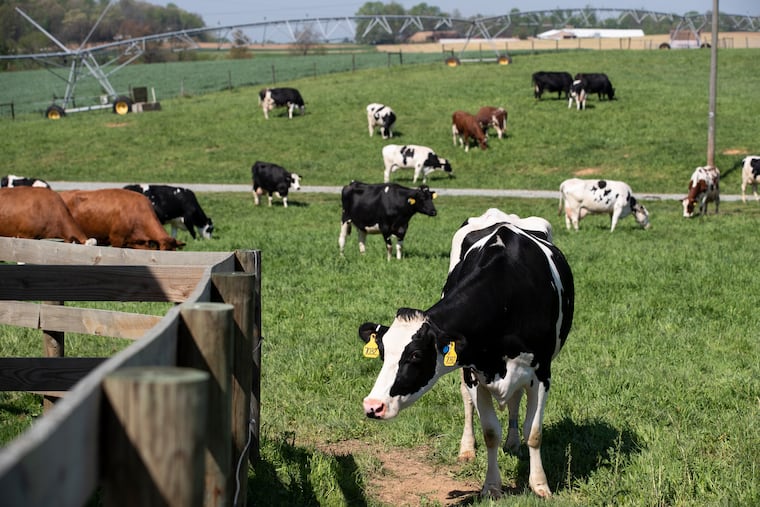Hershey’s chocolate comes full circle on Pennsylvania dairy farm. The cows love it.
Kit Kats, Reese's Pieces, Milk Duds. The Cargill food company is using leftover chocolate as an additive for livestock feed.

PEACH BOTTOM, Pa. — An unmistakable smell swirled in the dusty air during a recent, windy morning on a Lancaster County farm.
Red Knob Farm, a dairy operation a few miles north of the Maryland state line, is home to more than 1,500 cows, so there was that odor to contend with, of course. Workers had recently uncovered a large swath of winter rye that had been pickling under plastic too, but there was something more subtle wafting around, beyond the barns.
It was a brown powder, piled high inside a commodity shed. If you looked close enough, there were flecks of orange and yellow. It smelled sweet, like chocolate: Hershey’s Kit Kat to be specific.
“I think these are some broken-up Reese’s Pieces shells, “ said Jared Galbreath, Red Knob’s dairy manager. “I’d say most of this is Kit Kat, though.”
A not-so-scientific study once found that millions of Americans believed chocolate milk came from brown cows. Here at Red Knob Farm, and every other dairy farm in the world, the milk is white. But thanks to a partnership between Hershey’s and Cargill, a Minnesota-based food corporation, the Holsteins here are taking part in a real circle-of-life scenario with one of the world’s most-prized treats.
The cows are eating everything from Kisses to Milk Duds to Payday bars, all of it from Hershey plants, broken down into a powder, and mixed into Cargill’s feed.
And no, it doesn’t make the milk taste like chocolate.
“It will change the composition of the milk, but many types of formulas will do that, based on the farmer’s preferences,” said Darryl Reiner, a merchant with Cargill’s animal health & nutrition business.
The chocolate is an extra source of protein, fat, and sugar, Reiner said, but the biggest reason for recycling it is cutting back on waste. If not for the cows, the chocolate would be sent to a landfill.
Every day, Hershey plants in Pennsylvania and other states have leftover chocolate. Some of it’s excess from line changes and some could be from color or taste rejections. According to Cargill, the leftovers add up to tens of thousands of pounds of chocolate. They’ve dubbed the mix simply as “candy meal.”
“They might have to make peanut butter cakes one day and something else the next day, so those lines have to get cleaned out,” Reiner said.
Instead of going to a landfill, Hershey’s sends the chocolate to Cargill’s feed mill in Chambersburg, Franklin County, where it’s turned into an ingredient that cows, pigs, and other livestock can eat. About 35,000 tons of the chocolate feed a year is produced by Cargill and used on about 500 farms in the Northeast. The program was launched in 2011.
On a spring morning at Red Knob Farm earlier this month, third-generation farmer Andy Young said the decision to use recycled chocolate in his feed is part of a farm-wide effort to reuse everything, whether it’s food or manure.
“The way I see it, all of this land is on loan to us,” Young said.
Young’s farm is directly linked to the Chesapeake Bay by Little Conowingo Creek, which connects to the Susquehanna River, just a few miles west. It’s one of the reasons why Young doesn’t till his land — it limits runoff — and recycles as much cow waste as possible.
“Basically, anything that runs off the fields gets into the bay,” he said.
Some of the waste is pressed dry and broken down to a wood pulp for cow bedding. The liquid is stored and used as occasional “flush” to clean the barn floors.
“It just continues, in a loop, until spring and fall until all of that water is applied to the field to grow the corn crop and the rye crop,” he said.
Young said he’s been selling milk to Hershey for years. Hershey uses the milk to make chocolate, and now it’s coming back for the cows to eat: as perfect of a circle as you can get.
When it’s time for feeding, a man driving a loader takes large scoops of the chocolate, then some of the pickled rye, and dumps it precisely into a mixer truck. Some of it gets caught in the wind, coating any onlookers in a light dusting of powdered chocolate.
“Yeah, it’s not bad. You can eat it,” Galbreath said. “I’ve certainly been covered in worse.”